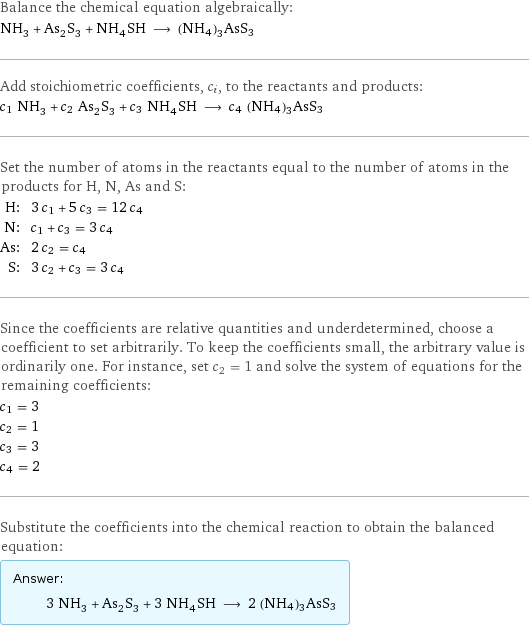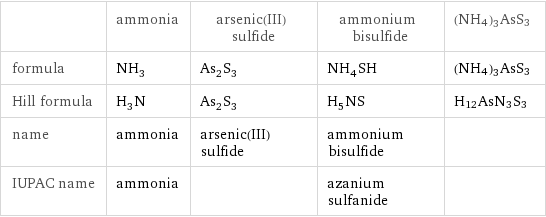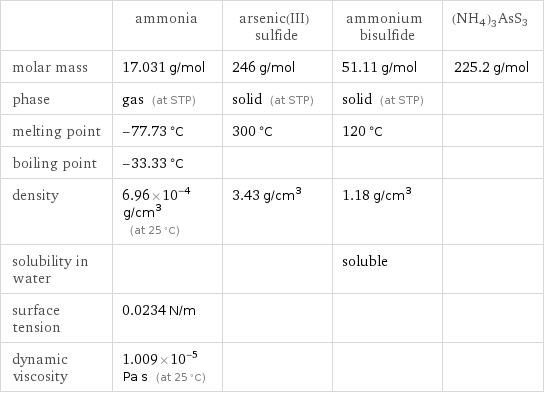Input interpretation

NH_3 ammonia + As_2S_3 arsenic(III) sulfide + NH_4SH ammonium bisulfide ⟶ (NH4)3AsS3
Balanced equation

Balance the chemical equation algebraically: NH_3 + As_2S_3 + NH_4SH ⟶ (NH4)3AsS3 Add stoichiometric coefficients, c_i, to the reactants and products: c_1 NH_3 + c_2 As_2S_3 + c_3 NH_4SH ⟶ c_4 (NH4)3AsS3 Set the number of atoms in the reactants equal to the number of atoms in the products for H, N, As and S: H: | 3 c_1 + 5 c_3 = 12 c_4 N: | c_1 + c_3 = 3 c_4 As: | 2 c_2 = c_4 S: | 3 c_2 + c_3 = 3 c_4 Since the coefficients are relative quantities and underdetermined, choose a coefficient to set arbitrarily. To keep the coefficients small, the arbitrary value is ordinarily one. For instance, set c_2 = 1 and solve the system of equations for the remaining coefficients: c_1 = 3 c_2 = 1 c_3 = 3 c_4 = 2 Substitute the coefficients into the chemical reaction to obtain the balanced equation: Answer: | | 3 NH_3 + As_2S_3 + 3 NH_4SH ⟶ 2 (NH4)3AsS3
Structures

+ + ⟶ (NH4)3AsS3
Names

ammonia + arsenic(III) sulfide + ammonium bisulfide ⟶ (NH4)3AsS3
Equilibrium constant
![Construct the equilibrium constant, K, expression for: NH_3 + As_2S_3 + NH_4SH ⟶ (NH4)3AsS3 Plan: • Balance the chemical equation. • Determine the stoichiometric numbers. • Assemble the activity expression for each chemical species. • Use the activity expressions to build the equilibrium constant expression. Write the balanced chemical equation: 3 NH_3 + As_2S_3 + 3 NH_4SH ⟶ 2 (NH4)3AsS3 Assign stoichiometric numbers, ν_i, using the stoichiometric coefficients, c_i, from the balanced chemical equation in the following manner: ν_i = -c_i for reactants and ν_i = c_i for products: chemical species | c_i | ν_i NH_3 | 3 | -3 As_2S_3 | 1 | -1 NH_4SH | 3 | -3 (NH4)3AsS3 | 2 | 2 Assemble the activity expressions accounting for the state of matter and ν_i: chemical species | c_i | ν_i | activity expression NH_3 | 3 | -3 | ([NH3])^(-3) As_2S_3 | 1 | -1 | ([As2S3])^(-1) NH_4SH | 3 | -3 | ([NH4SH])^(-3) (NH4)3AsS3 | 2 | 2 | ([(NH4)3AsS3])^2 The equilibrium constant symbol in the concentration basis is: K_c Mulitply the activity expressions to arrive at the K_c expression: Answer: | | K_c = ([NH3])^(-3) ([As2S3])^(-1) ([NH4SH])^(-3) ([(NH4)3AsS3])^2 = ([(NH4)3AsS3])^2/(([NH3])^3 [As2S3] ([NH4SH])^3)](../image_source/a11218f0fe437a07ce01129a2ad81cb4.png)
Construct the equilibrium constant, K, expression for: NH_3 + As_2S_3 + NH_4SH ⟶ (NH4)3AsS3 Plan: • Balance the chemical equation. • Determine the stoichiometric numbers. • Assemble the activity expression for each chemical species. • Use the activity expressions to build the equilibrium constant expression. Write the balanced chemical equation: 3 NH_3 + As_2S_3 + 3 NH_4SH ⟶ 2 (NH4)3AsS3 Assign stoichiometric numbers, ν_i, using the stoichiometric coefficients, c_i, from the balanced chemical equation in the following manner: ν_i = -c_i for reactants and ν_i = c_i for products: chemical species | c_i | ν_i NH_3 | 3 | -3 As_2S_3 | 1 | -1 NH_4SH | 3 | -3 (NH4)3AsS3 | 2 | 2 Assemble the activity expressions accounting for the state of matter and ν_i: chemical species | c_i | ν_i | activity expression NH_3 | 3 | -3 | ([NH3])^(-3) As_2S_3 | 1 | -1 | ([As2S3])^(-1) NH_4SH | 3 | -3 | ([NH4SH])^(-3) (NH4)3AsS3 | 2 | 2 | ([(NH4)3AsS3])^2 The equilibrium constant symbol in the concentration basis is: K_c Mulitply the activity expressions to arrive at the K_c expression: Answer: | | K_c = ([NH3])^(-3) ([As2S3])^(-1) ([NH4SH])^(-3) ([(NH4)3AsS3])^2 = ([(NH4)3AsS3])^2/(([NH3])^3 [As2S3] ([NH4SH])^3)
Rate of reaction
![Construct the rate of reaction expression for: NH_3 + As_2S_3 + NH_4SH ⟶ (NH4)3AsS3 Plan: • Balance the chemical equation. • Determine the stoichiometric numbers. • Assemble the rate term for each chemical species. • Write the rate of reaction expression. Write the balanced chemical equation: 3 NH_3 + As_2S_3 + 3 NH_4SH ⟶ 2 (NH4)3AsS3 Assign stoichiometric numbers, ν_i, using the stoichiometric coefficients, c_i, from the balanced chemical equation in the following manner: ν_i = -c_i for reactants and ν_i = c_i for products: chemical species | c_i | ν_i NH_3 | 3 | -3 As_2S_3 | 1 | -1 NH_4SH | 3 | -3 (NH4)3AsS3 | 2 | 2 The rate term for each chemical species, B_i, is 1/ν_i(Δ[B_i])/(Δt) where [B_i] is the amount concentration and t is time: chemical species | c_i | ν_i | rate term NH_3 | 3 | -3 | -1/3 (Δ[NH3])/(Δt) As_2S_3 | 1 | -1 | -(Δ[As2S3])/(Δt) NH_4SH | 3 | -3 | -1/3 (Δ[NH4SH])/(Δt) (NH4)3AsS3 | 2 | 2 | 1/2 (Δ[(NH4)3AsS3])/(Δt) (for infinitesimal rate of change, replace Δ with d) Set the rate terms equal to each other to arrive at the rate expression: Answer: | | rate = -1/3 (Δ[NH3])/(Δt) = -(Δ[As2S3])/(Δt) = -1/3 (Δ[NH4SH])/(Δt) = 1/2 (Δ[(NH4)3AsS3])/(Δt) (assuming constant volume and no accumulation of intermediates or side products)](../image_source/d3cfb1734dbb2ac416482a089fc73564.png)
Construct the rate of reaction expression for: NH_3 + As_2S_3 + NH_4SH ⟶ (NH4)3AsS3 Plan: • Balance the chemical equation. • Determine the stoichiometric numbers. • Assemble the rate term for each chemical species. • Write the rate of reaction expression. Write the balanced chemical equation: 3 NH_3 + As_2S_3 + 3 NH_4SH ⟶ 2 (NH4)3AsS3 Assign stoichiometric numbers, ν_i, using the stoichiometric coefficients, c_i, from the balanced chemical equation in the following manner: ν_i = -c_i for reactants and ν_i = c_i for products: chemical species | c_i | ν_i NH_3 | 3 | -3 As_2S_3 | 1 | -1 NH_4SH | 3 | -3 (NH4)3AsS3 | 2 | 2 The rate term for each chemical species, B_i, is 1/ν_i(Δ[B_i])/(Δt) where [B_i] is the amount concentration and t is time: chemical species | c_i | ν_i | rate term NH_3 | 3 | -3 | -1/3 (Δ[NH3])/(Δt) As_2S_3 | 1 | -1 | -(Δ[As2S3])/(Δt) NH_4SH | 3 | -3 | -1/3 (Δ[NH4SH])/(Δt) (NH4)3AsS3 | 2 | 2 | 1/2 (Δ[(NH4)3AsS3])/(Δt) (for infinitesimal rate of change, replace Δ with d) Set the rate terms equal to each other to arrive at the rate expression: Answer: | | rate = -1/3 (Δ[NH3])/(Δt) = -(Δ[As2S3])/(Δt) = -1/3 (Δ[NH4SH])/(Δt) = 1/2 (Δ[(NH4)3AsS3])/(Δt) (assuming constant volume and no accumulation of intermediates or side products)
Chemical names and formulas

| ammonia | arsenic(III) sulfide | ammonium bisulfide | (NH4)3AsS3 formula | NH_3 | As_2S_3 | NH_4SH | (NH4)3AsS3 Hill formula | H_3N | As_2S_3 | H_5NS | H12AsN3S3 name | ammonia | arsenic(III) sulfide | ammonium bisulfide | IUPAC name | ammonia | | azanium sulfanide |
Substance properties

| ammonia | arsenic(III) sulfide | ammonium bisulfide | (NH4)3AsS3 molar mass | 17.031 g/mol | 246 g/mol | 51.11 g/mol | 225.2 g/mol phase | gas (at STP) | solid (at STP) | solid (at STP) | melting point | -77.73 °C | 300 °C | 120 °C | boiling point | -33.33 °C | | | density | 6.96×10^-4 g/cm^3 (at 25 °C) | 3.43 g/cm^3 | 1.18 g/cm^3 | solubility in water | | | soluble | surface tension | 0.0234 N/m | | | dynamic viscosity | 1.009×10^-5 Pa s (at 25 °C) | | |
Units
